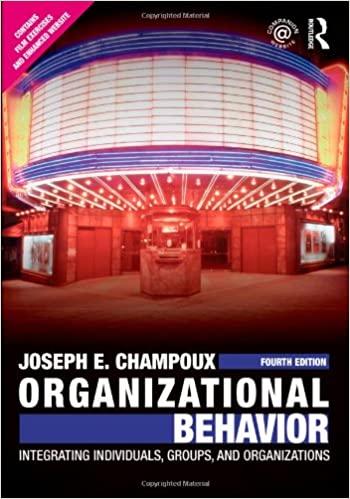Discuss the differences among dominance, compromise, and integration as approaches to reducing conflict. Mary Parker Follett described
Question:
Discuss the differences among dominance, compromise, and integration as approaches to reducing conflict. Mary Parker Follett described these approaches to conflict reduction. Does integration of desires impress you as a feasible approach to conflict reduction?
Mary Parker Follett’s Observations on Organizations and Management (1925)
Mary Parker Follett was a social worker among the poor in the Roxbury section of Boston. Although her work career did not involve management, she made several basic and enduring observations about organizations and management during the mid-1920s to the early 1930s. The following paragraphs describe three of her observations on organizations and management: power, conflict, and leadership. Follett conceived of power as capacity. Although her point was not completely clear, she apparently meant the capacity to get things done. Power cannot be delegated, but authority can. She clearly distinguished between power and authority, treating each separately in her analysis.
Follett distinguished power-over from power-with. Power-overis dominance, coercion, and control based on force. Power-with is “a jointly developed power, a co-active, not a coercive power.” She offered power-with as an alternative to power-over, because she believed human organizations were cooperative systems. Follett had a positive view of power and saw it as basic to organizations and management.
Follett’s analysis of conflict appeared in the unusually titled paper “Constructive Conflict.” Follett felt conflict was neither good nor bad. Conflict is difference, not warfare. The differences can be in opinions or interests. She felt conflict could not be avoided. Instead of running from conflict, managers should put conflict to use in their organizations.
Follett felt there were three ways to manage conflict: dominance, compromise, and integration of desires. Dominance means one side of a conflict wins over the other. Compromise means each side gives up something to settle the issue. In each instance, the basic conflict issue is not settled. Although one party wins, or both parties agree on settling the dispute, the reason for the conflict remains. Conflict could later occur about the same matter or issue.
Integration of desires was Follett’s creative suggestion for managing conflict. This approach finds a solution that fully meets the goals of each party in a dispute. Both parties get what they want. Neither party gives up anything. Integration of desires unshackles you from existing alternatives and lets you creatively discover alternatives that are not mutually exclusive. Integration discovers something; compromise uses only what exists. With integration, conflict is put to work to help discover new, creative solutions to problems and issues in organizations.
Step by Step Answer:

Organizational Behavior Integrating Individuals Groups And Organizations
ISBN: 9780415804646
4th Edition
Authors: Joseph E. Champoux





